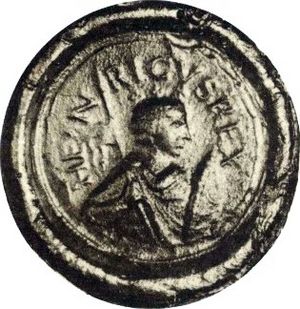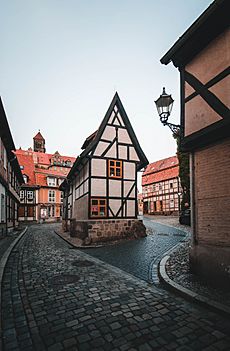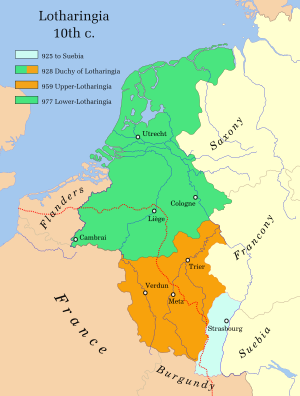Henry the Fowler facts for kids
Quick facts for kids Henry the Fowler |
|
|---|---|

Henry's seal from a document of 30 March 925. He is portrayed as a warrior, with a spear and shield. The words are HEINRICUS REX (King Henry).
|
|
| King of East Francia | |
| Reign | c. 24 May 919 – 2 July 936 |
| Coronation | c. 24 May 919 |
| Predecessor | Conrad the Younger |
| Successor | Otto the Great |
| Duke of Saxony | |
| Reign | 30 November 912 – 2 July 936 |
| Predecessor | Otto the Illustrious |
| Successor | Otto the Great |
| Born | c. 7 July 876 Mimileba, East Francia |
| Died | 2 July 936 (aged 59–60) Mimileba, East Francia |
| Burial | Quedlinburg Abbey |
| Spouse |
|
| Issue |
|
| Dynasty | Ottonian |
| Father | Otto I, Duke of Saxony |
| Mother | Hedwiga |
| Religion | Chalcedonian Christianity |
Henry the Fowler (also known as Heinrich der Vogler in German) was a very important leader in early German history. He was the Duke of Saxony starting in 912. Later, in 919, he became the King of East Francia. This was a big deal because he was the first king who wasn't from the Frankish family.
Henry started the Ottonian dynasty, a powerful family of kings and emperors. Many people see him as the person who founded the medieval German state. He got his nickname "the Fowler" because he loved hunting birds. The story says that when messengers came to tell him he would be king, he was busy fixing his bird nets!
He was born around 876 into the Liudolfing family of Saxon dukes. When his father, Otto I, passed away in 912, Henry took over as duke. He had some disagreements with the previous king, Conrad I of Germany. But before Conrad died in 918, he actually suggested Henry should be the next king. Conrad believed Henry was the only one strong enough to keep the kingdom together. This was important because there were internal conflicts and attacks from the Magyars.
Contents
Becoming King of East Francia
Henry was chosen as king in 919. He then worked to bring all the different parts of the kingdom under his control. He defeated powerful dukes like Arnulf of Bavaria and Burchard II of Swabia. This helped him make his rule stronger.
One of his big achievements was gaining control of Lotharingia in 925. He did this through successful battles and by arranging a marriage for his daughter. Unlike earlier kings, Henry didn't try to create a super-centralized government. Instead, he let the different regions, called stem duchies, keep some of their own power.
Henry also built many forts and trained a strong army of heavy cavalry. This was to protect his lands from the Magyar invaders. In 933, he famously defeated the Magyars at the Battle of Riade. This victory stopped their attacks for over 20 years and helped create a feeling of German identity.
He also expanded German power by defeating the Slavs in 929 at the Battle of Lenzen. He made the Duke Wenceslaus I of Bohemia accept his rule and conquered Danish lands in Schleswig in 934. Other kings in Europe recognized Henry's power. He planned to travel to Rome to be crowned emperor, but he died before he could do so. Henry left a much stronger kingdom for his son, Otto I. He was buried at Quedlinburg Abbey, a place his wife Matilda had founded.
Henry's Family Life

Henry was born in Memleben, in what is now Germany. His parents were Otto the Illustrious, Duke of Saxony, and Hedwiga.
In 906, Henry married Hatheburg of Merseburg. She had been a nun before. Their marriage was later cancelled in 909 because her vows as a nun were still considered valid by the church. They had one son named Thankmar.
Later that same year, Henry married Matilda. She was the daughter of Dietrich of Ringelheim. Matilda and Henry had three sons and two daughters: Hedwig, Gerberga, Otto I, Henry I, and Bruno. Matilda also founded many religious places, including Quedlinburg Abbey, where she and Henry are buried. She was later made a saint.
His son, Otto I, often called Otto the Great, continued his father's work. Otto united the German tribes and made the king's power even stronger. He placed family members in important positions, controlled the church, defeated the Magyars, and conquered the Kingdom of Italy.
Important Conflicts and Victories
As Duke of Saxony, Henry worked to make his region stronger. He often had conflicts with his neighbors.
When King Conrad I died in 918, he suggested Henry as his successor. This was a big change, as kingship moved from the Franks to the Saxons. Henry was chosen as king in 919. He was offered a special church ceremony to become king, but he refused. He wanted to be king because the people chose him, not just the church.
Henry had to make sure all the other powerful dukes accepted him as king. Duke Burchard II of Swabia quickly swore loyalty. But Duke Arnulf of Bavaria was much harder to convince. Arnulf had even crowned himself king of Bavaria! Henry had to fight two campaigns against Arnulf in 921 to make him submit. Arnulf eventually gave up his claim to be king but kept a lot of power in Bavaria.
Gaining Lotharingia
In 920, the king of West Francia, Charles the Simple, tried to invade Henry's lands. But Charles retreated when he heard Henry was gathering an army. In 921, Henry and Charles met and signed the Treaty of Bonn. This treaty recognized Henry as the king of East Francia.
Later, a civil war started in West Francia. Henry saw this as a chance to take Lotharingia. In 923, he crossed the Rhine river and captured a large part of the duchy. In 925, Duke Gilbert of Lotharingia rebelled against Henry. Henry invaded and defeated Gilbert. He allowed Gilbert to remain duke but made him his vassal (a ruler who owes loyalty to a higher king). Henry also arranged for his daughter Gerberga to marry Gilbert in 928. This brought Lotharingia back into the kingdom.
Stopping the Magyar Raids
The constant threat from Magyar raiders actually helped Henry. It made all the dukes and nobles realize they needed a strong king to protect them.
In 919, Henry was defeated by the Magyars in the Battle of Püchen. He barely escaped with his life. In 921, the Magyars invaded again.
Henry managed to capture a Hungarian prince. This allowed him to arrange a ten-year truce in 924. During this time, Henry agreed to pay the Magyars a yearly tribute. This gave him and the dukes time to build new fortified towns and train a new, strong cavalry army.
In 932, Henry refused to pay the tribute. When the Magyars started raiding again, Henry's improved army crushed them at the Battle of Riade in 933. This was such a complete victory that the Magyars did not attack Henry's northern lands for the next 21 years.
Expanding Eastward: Wars with Slavs
During the truce with the Magyars, Henry focused on the Polabian Slavs who lived on his eastern borders. In the winter of 928, he attacked the Slavic Hevelli tribes and captured their capital, Brandenburg. He then conquered the Glomacze lands and built a fortress at Meissen.
In 929, with help from Arnulf of Bavaria, Henry entered the Duchy of Bohemia. He forced Duke Wenceslaus I to start paying tribute to the king again.
Henry's forces also defeated the Slavic Redarii at the Battle of Lenzen in 929. The Lusatians and the Ukrani were also brought under control and made to pay tribute in 932 and 934.
Controlling the North: Wars with Danes
Henry also brought peace to the northern areas. The Danes had been attacking the Frisians by sea. A monk named Widukind of Corvey wrote that the Danes became subjects of Henry. Henry took control of lands held by the Wends, who had attacked Germany with the Danes. He also conquered Schleswig in 934.
Henry's Children
| German royal dynasties | |
|---|---|
| Ottonian dynasty | |
|
Chronology
|
|
| Henry I |
919 – 936
|
| Otto I |
936 – 973
|
| Otto II |
973 – 983
|
| Otto III |
983 – 1002
|
| Henry II |
1002 – 1024
|
|
Family
|
|
| Ottonian dynasty family tree Family tree of the German monarchs Category:Ottonian dynasty |
|
|
Succession
|
|
| Preceded by Conradine dynasty | |
| Followed by Salian dynasty | |
As the first Saxon king, Henry was the founder of the Ottonian dynasty. His family ruled East Francia and later the Holy Roman Empire until 1024.
Henry had two wives and at least six children:
- With Hatheburg:
- Thankmar (908–938) – He rebelled against his half-brother Otto and was killed in battle.
- With Matilda:
- Hedwig (910–965) – She married a powerful duke named Hugh the Great from West Francia. She was the mother of Hugh Capet, who became King of West Francia.
- Otto I (912–973) – He became Duke of Saxony, King of East Francia, and later the Holy Roman Emperor. In 929, Henry arranged for Otto to marry Eadgyth, the daughter of King Edward the Elder of Wessex.
- Gerberga (913–984) – She married (1) Duke Gilbert of Lotharingia and (2) King Louis IV of France.
- Henry I (919–955) – He became Duke of Bavaria.
- Bruno (925–965) – He became Archbishop of Cologne and Duke of Lotharingia. He also served as a regent (someone who rules for a young king) in West Francia.
Henry's Legacy and Influence
Henry the Fowler became a character in Richard Wagner's opera, Lohengrin (1850). In the opera, he tries to get support from nobles to fight the Magyars. After attempts to unite Germany failed in 1848, Wagner used Henry's image as a ruler who united all German tribes.
Some people, like Heinrich Himmler during the Nazi era, saw Henry as a very important figure. Himmler even believed he was the reincarnation of Henry. He visited Henry's grave in Quedlinburg many times to hold ceremonies on the anniversary of Henry's death. Himmler called Henry the "first German king" and made his tomb a special place for Germans to visit. In 1937, Henry's remains were placed in a new sarcophagus.
Henry in Popular Culture
- Henry the Fowler is a main character in Richard Wagner's opera Lohengrin.
- Henry the Fowler is one of the bad guys in the 2001 video game Return to Castle Wolfenstein.
See also
 In Spanish: Enrique I de Sajonia para niños
In Spanish: Enrique I de Sajonia para niños
- Family tree of the German monarchs




